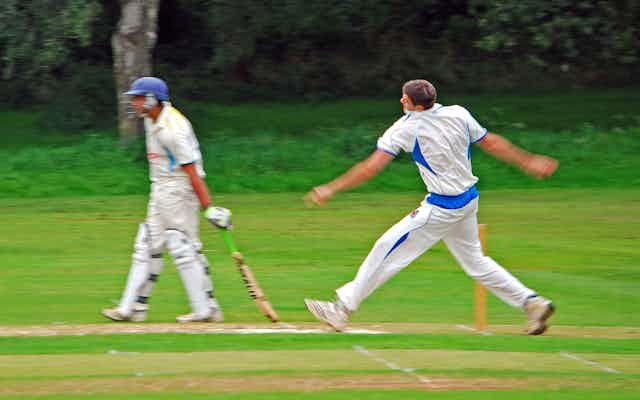Good fast bowlers add plenty of spice to the game of cricket but they’re also prone to bowling no-balls. If they just started their run ups from a little further back most could probably eliminate no-balls altogether, so why do they risk it?
By releasing the ball as close to the batsman as possible they bowl, in effect, more quickly and increase their chances of obtaining a wicket. But by bowling too close they must accept the risk of bowling a no-ball.
Occasionally these two things happen together. All the heartache and toil of the bowler comes to nothing as the batsman remains at the crease; the bowler has salt rubbed into his wounds as he concedes a run and has to re-bowl the delivery.
This happened in the First Test at Adelaide during Australia’s second innings against India. Varun Aaron bowled David Warner, but Warner was given a lifeline because Aaron had bowled a no-ball.
It also happened in the game between New Zealand and Pakistan during the Kiwi tour of the United Arab Emirates in December – Mitchell McClenaghan had Younis Khan out LBW for a duck, only for Younis to be recalled as it was a no-ball.
What chance the no-ball from a fast bowler?
What are the odds of dismissing a batsman off a no-ball?
Suppose a bowler bowls B balls, N of which are no-balls, and takes W wickets. What is the chance that at least one of these wickets will be taken on a no-ball?
We can consider this by using the binomial coefficients: the number of ways of choosing X objects from a pool of Y objects – we call this “Y-choose-X” and evaluate it as Y!/(X!(Y-X)!), where Y! Means 1x2x3x … xY. For example “6-choose-2”, the number of ways of positioning the two legal bouncers in an over is 6!/(4! x 2!) = 15.
Returning to our odds of no-balls, let us consider Ishant Sharma’s bowling in the 1st innings in the Brisbane test. He bowled 23 overs (that is, 138 balls), 6 no-balls, and collected 3 wickets.
How many ways can we arrange these 3 wickets? 138-choose-3 ways. How many ways can we arrange the wickets such that none of them fall on no-balls? There are 138 less 6 legal deliveries, hence we have 132-choose-3 ways.
Therefore, the probability that none of these wickets fell on a no-ball is (132-choose-3)/(138-choose-3) which is roughly 0.874, or 87.4%.
Therefore there is roughly a 12.6% (or 1-in-8) chance of at least one of these wickets falling on a no-ball. This is surprisingly high and an obvious risk for any fast bowler. What’s more, this figure increases as the expected number of wickets increases.
It therefore seems ludicrous that fast bowlers would bowl no-balls: the risks are too great.
If, say, over 20 paces in their run-ups they stretch a little bit further and each pace is 5 mm longer, they are out by 10 cm. It seems all the more sensible to bowl, not with the end of the heel just behind the crease, but with the crease cutting the front shoe in half. That way, being out by 10 cm or so will not result in a no-ball.
Close but not too close
But, what will this do to the pace of the delivery? Bowling further away from the batsman surely gives the batsman more time to prepare for the delivery, and hence, reduces his chances of dismissal.
What is the cost of bowling further away?
Law 24.5(b) states that the bowler must have some part of the front foot, whether grounded or raised, behind the popping crease when entering his delivery stride.

The distance from popping crease to popping crease is 17.68 metres. Even though the batsman may bat within or outside of his crease, we will take this distance as the distance between the ball at point of release and the batsman.
The question is: how does the apparent speed of the bowler change relative to the point of release?
It is not so much the speed of the ball that is important, but rather the time the batsman has to play it. A ball delivered on the popping crease at 140km/h takes around 0.455 seconds to reach the batsman.
Suppose now that the bowler delivered the ball from some distance D behind the popping crease. We can convert the time taken for this delivery into an apparent speed, that is, the speed at which the bowler would appear to be bowling had he bowled from the popping crease.
A little algebra shows that this apparent speed will be (17.68 x 140)/(17.68 + D) km/h.
Suppose we choose D to be 15 cms so that the popping crease now cuts the bowler’s shoe in half. The bowler’s apparent speed drops from 140km/h to 138.82 km/h. This variation is well within the natural ups and downs within a bowler’s spell.
By bowling with the heel well behind the popping crease (15 cms or so) the bowler reduces his chances of taking a wicket on a no-ball from 1-in-8 to virtually zero, simply because he will not bowl a front-foot no-ball.
His speed does certainly drop, but so imperceptibly as not to make any difference.
The article was edited on January 8 as the request of the Author to correct the errors in some of the mathematics pointed out in some of the comments.

